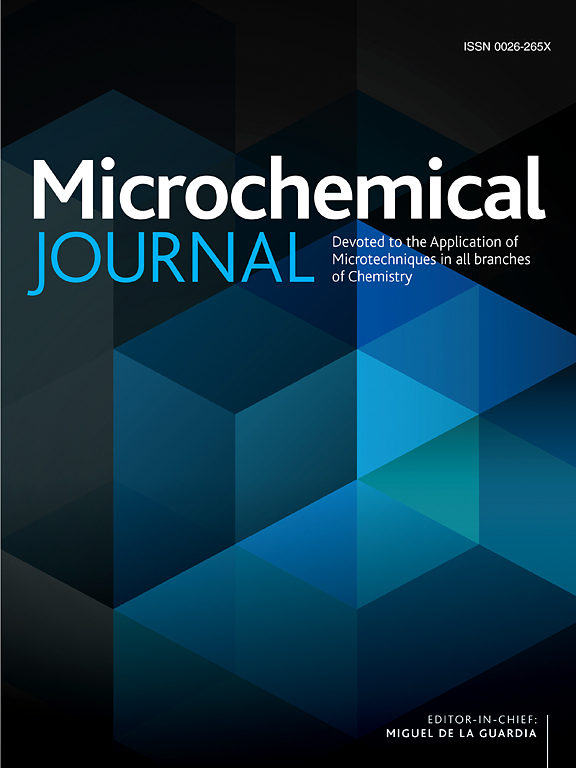High-sensitivity label-free electrochemical genosensors for carbon nanotube plasmon-assisted detection of somatic mutations in nucleic acids from formalin-fixed paraffin-embedded tissues
IF 4.9
2区 化学
Q1 CHEMISTRY, ANALYTICAL
引用次数: 0
Abstract
Currently, molecular genetic testing of somatic point mutations in the genome of cancer tumors for targeted therapy requires high-performance tools for studies of spatial gene expression and spatial genome profiling in formalin-fixed paraffin-embedded (FFPE) tissue samples. We offer new high-performance label-free electrochemical impedimetric deoxyribonucleic-acid (DNA) nanosensors. The sensors based on a platform of crystalline carbon nanotube plasmonic assemblies are fabricated by the Langmuir–Blodgett deposition technique. The carbon-nanotube assemblies are suspended on nanoporous supports. Incorporation of fast Fourier transforms in the impedance spectroscopy led to the introduction of a new information parameter, the integral value of capacitance changes. The allele-sensitive assay based on plasmon-assisted effects in the assemblies of electrically active conjugates between DNA and few-walled carbon nanotubes has been used for discrimination of allele single-nucleotide polymorphisms (SNPs) of Kirsten Rat Sarcoma viral oncogene homologue (KRAS gene). Using 19- and 20-mer single-stranded (ss) probe oligonucleotides and 35- and 47-mer toehold probes, we explored the probe length and the target location. The genotyping technology allows discrimination of single-nucleotide variations in the target 35-base oligonucleotide at the attomolar concentration level. Human genomic DNAs were isolated from FFPE colorectal cancer tumor tissue samples. The KRAS-gene exon 2, codon 12, c.35GA mutation has been successfully discriminated in the genomic DNAs with a significance level, P, of 0.001–0.02. The assay has a sensitivity with 0.33-ng/ml limit of detection (LOD) for native genomic DNA.

高灵敏度无标记电化学基因传感器用于碳纳米管等离子体辅助检测福尔马林固定石蜡包埋组织中核酸的体细胞突变
目前,针对靶向治疗的肿瘤基因组体细胞点突变的分子遗传学检测需要高性能的工具来研究福尔马林固定石蜡包埋(FFPE)组织样本中的空间基因表达和空间基因组谱。我们提供新的高性能无标签电化学阻抗法脱氧核糖核酸(DNA)纳米传感器。基于晶体碳纳米管等离子体组件平台的传感器采用Langmuir-Blodgett沉积技术制备。碳纳米管组件悬浮在纳米孔支架上。在阻抗谱中引入快速傅里叶变换,引入了一个新的信息参数,即电容变化的积分值。基于等离子体辅助作用的DNA与碳纳米管电活性偶联物组装的等位基因敏感检测已被用于Kirsten大鼠肉瘤病毒癌基因同源物(KRAS基因)等位基因单核苷酸多态性(snp)的鉴别。利用19-和20-mer单链(ss)探针寡核苷酸和35-和47-mer脚探针,我们探索了探针长度和目标位置。基因分型技术允许在原子摩尔浓度水平上对目标35碱基寡核苷酸的单核苷酸变异进行区分。从FFPE结直肠癌肿瘤组织样本中分离出人类基因组dna。kras基因外显子2,密码子12,c.35G>;A突变在基因组dna中被成功区分,显著性水平P为0.001-0.02。该方法对本地基因组DNA的检测限为0.33 ng/ml。
本文章由计算机程序翻译,如有差异,请以英文原文为准。
求助全文
约1分钟内获得全文
求助全文
来源期刊

Microchemical Journal
化学-分析化学
CiteScore
8.70
自引率
8.30%
发文量
1131
审稿时长
1.9 months
期刊介绍:
The Microchemical Journal is a peer reviewed journal devoted to all aspects and phases of analytical chemistry and chemical analysis. The Microchemical Journal publishes articles which are at the forefront of modern analytical chemistry and cover innovations in the techniques to the finest possible limits. This includes fundamental aspects, instrumentation, new developments, innovative and novel methods and applications including environmental and clinical field.
Traditional classical analytical methods such as spectrophotometry and titrimetry as well as established instrumentation methods such as flame and graphite furnace atomic absorption spectrometry, gas chromatography, and modified glassy or carbon electrode electrochemical methods will be considered, provided they show significant improvements and novelty compared to the established methods.
 求助内容:
求助内容: 应助结果提醒方式:
应助结果提醒方式:


